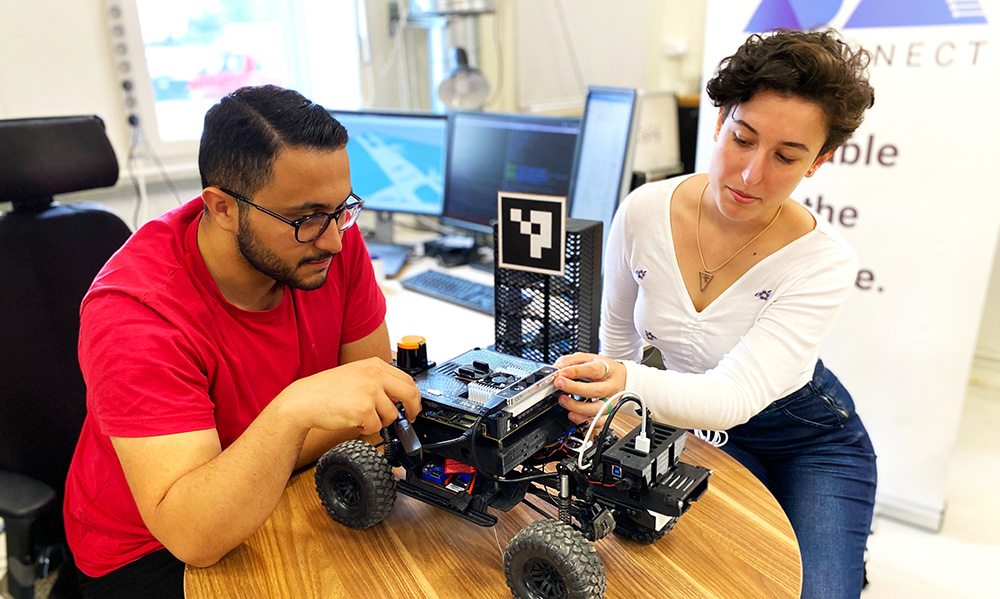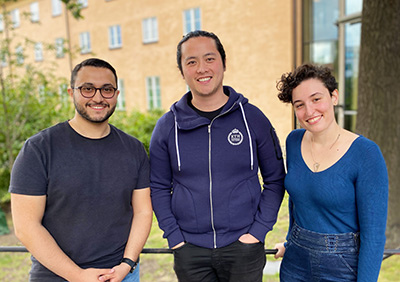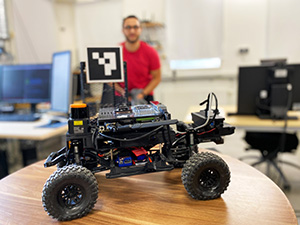They want to help robots collaborate

Imagine that you are riding in a self-driving car in a city. Out of sight, someone gets off a bus and starts walking out into the street. Your car can only react to what it can see, which means that you are now at risk of hitting a pedestrian. But what if the bus could warn your car that someone is about to step into your path? That’s the future KTH spinoff ABConnect wants to create.

Smart cities where vehicles communicate with each other. Connected farms where fleets of machines work together to sow and harvest. Drones delivering goods to moving trucks. One of the teams in Batch 14 of the KTH Innovation pre-incubator program is ABConnect. They are on a mission to make it easier for robots to communicate with each other to create a smarter future.
- More and more robots are deployed every day, but today there is no off-the-shelf system that lets them communicate with each other and with other devices in a reliable and efficient way, says Frank Jiang, co-founder of ABConnect. We are building a solution to let companies create a communication network between their computer systems and automated robots.
Met in the lab
ABConnect was founded by three people connected to the Integrated Transport and Research Lab (ITRL) at KTH. Mustafa Al-Janabi first got in contact with ITRL during a project course. After the course ended, he got a part-time job as a research engineer. There, he met Frank Jiang and Elisa Bin both PhD students in the Division of decision and control systems, and affiliated with ITRL. They started working together on the system that was to become ABConnect's first product.
- As researchers we work on autonomous vehicles, says Frank. The idea behind our solution stems from the fact that autonomous vehicles cannot solve problems that they can’t see. If they were able to use information from other vehicles, maybe someone’s phone, the road network and so on, that would enhance the safety of the road.
A problem shared by many
The team soon realized they had found a problem worth solving.
- In a way, we just built a solution to our own problems, says Mustafa. After chatting to KTH Innovation, we figured that other people or companies might experience this problem as well. After looking around, we saw that there were commercial possibilities. We couldn’t find any solutions that solved the problem in a way that scales well and does it dynamically.
Can be used on smart farms
The need for this kind of system is likely to grow the more connected and automated our society becomes. One example is so called smart or precision farming, when farmers use automated robots to work their fields.
- If you deploy a fleet of automated robots to harvest a field, our solution makes it easy to collect data from their sensors in a centralized way, says Elisa. They can collaborate on building a map of the area, and we can for example communicate to different agents where they are allowed to go or not. And if something unexpected happens, like a child walking onto the field, the robots should be able to communicate and react immediately.
Met others with similar struggles
In the pre-incubator program, Frank, Elisa and Mustafa found a community of other teams passionate about developing their own ideas. The program runs for twelve months and gives access to prioritized support from the KTH Innovation team, weekly workshops about business development, and a clear path to follow.
- We got to meet so many other teams that have similar struggles to us but are going through a different journey, says Elisa. There is a lot to learn, both from the coaches, but also between each other, like in finding ways to help each other out and getting to know new opportunities. I think that was really what sticks out the most to me.
Common ground
The program is open to teams founded by students, researchers and employees at KTH. It builds on KTH Innovation’s open support and is aimed at the teams that are the most motivated to make their solutions come to life.
- It’s very refreshing, says Frank. As researchers, we usually just interact with other researchers, and especially ones that are in our own, narrow field. So, it’s really nice to have the common ground of wanting to start a startup with all of these people from different parts of KTH, because we’re all connected through engineering.
Combining work, studies, and startup development

Everyone in the program combines their work or studies with developing their startup projects. Finding structure can be hard but having a clear plan to follow usually makes things easier.
- The easiest way to appreciate something is to imagine what it would be like if you didn't have it, and I can't imagine us getting anywhere if we haven't had this opportunity to be part of KTH Innovation, says Mustafa.
See many application areas
In the past year, team ABConnect has started pilot projects and received commercialization funding from the Swedish Foundation for Strategic Research, SSF. In the future, they hope to be able to contribute to a more connected world, where we can solve humanity’s challenges in a more efficient and sustainable way. They see their software being used in a vast number of different applications, from understanding our forests, reducing emissions from roads and vehicles, to reducing water usage on farms.
- Communication between humans is hard, and between robots it’s even harder, says Mustafa. We want to help robots become smarter and more collaborative, so they can help us out. Our slogan is “Enable the future”, and that is really our vision for ABConnect. In five years, we hope to be a bigger team, and have our software running in more than one country.
By: Lisa Bäckman

